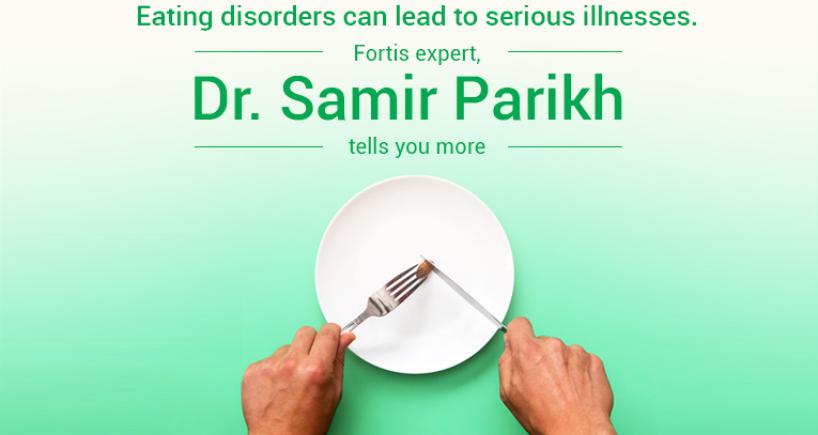
Eating Disorders

There is a clearly bidirectional relationship between food and our emotions, which can be often witnessed in our daily experiences. For instance, tendencies commonly referred to as comfort eating, which is a tendency to desire more junk foods especially during times of stress, as opposed to the tendency to lose one’s appetite in times of stress or tension. Food ends up meaning much more than simply nutrients; it gets intertwined with our emotions. Almost all of us do at some point of time eat too much or little, have cravings, or makes efforts to eat more healthy food. However, while wrong or unhealthy eating habits could be detrimental to our health, many of us are not aware of the existence of a category of disorders specifically referring to an individual’s eating behavior. It is therefore not surprising to note an emerging trend of eating disorders in India In fact, eating disorders are increasing in prevalence, especially amongst adolescents and females.
Eating disorders refer to extreme disturbances in eating behaviour, wherein the urge to eat less or more is no more in the person’s control, and the person feels distressed about his or her body weight and shape. Such disorders broadly comprise of restrictive behaviours including dieting, fasting or excessive exercising, and/or overeating/purging behaviours including self-induced vomiting, or the misuse of laxatives, diuretics or enemas. While eating disorders commonly have an onset in late childhood or early adolescence, the lack of awareness may lead to diagnoses of these disorders in adulthood as well. Commonly observed habits amongst individuals with eating disorders could include following rigid diets, secretly bingeing on food, throwing up after meals, or obsessively counting calories.
Many of us may relate eating disorders to unhealthy eating habits. However, it is important to remember that there are biological mechanisms underlying the development as well as the consequences of these eating disorders, in addition to the psychology beneath these maladaptive eating patterns that are capable of creating havoc in our lives. While almost all of us have some ideas of wanting to look a particular way, with our desires of a range of body weight or shape. As such desires begin to shape our belief system, and become more of a preoccupation or obsession, various psychological factors come into play. It has been clearly established that there seems to be strong relationship of eating disorders with depression, anxiety, poor self-esteem, substance use, anger, loneliness, inadequacy and other mental conditions. Psychological factors like maladaptive attitudes or beliefs about eating, or body shape, identity conflicts, or overvaluation of appearance are also etiologically associated with eating disorders. Other psychological and social stressors like trauma, childhood abuse, insecure attachment, bullying, or dysfunctional families have also been found to contribute to the etiological development of eating disorders.
Furthermore, socialization plays a significant role in the exacerbation and maintenance of eating disorders, as there are a wide range of situations which could precipitate or trigger maladaptive beliefs and eating patterns, especially in those predisposed with a susceptibility to them. In addition, the role of sociocultural components contributing to the development of eating disorders is undeniable. Peer and media influences play a major role in deciding the idealized body shapes, and the expectations and perceptions related to self-image, especially for children and adolescents, tending to choose their role models based on the mass media. Furthermore, glamorization and internalization of the thin ideals, dieting, and body dissatisfaction are often ingredients embedded in some cultures.
Contrary to popular myths, eating disorders are not simply a lifestyle choice, or a normal part of adolescence. Eating disorders are a serious illness with physical and psychological consequences, but recovery is possible with the help of adequate psychiatric and psychological intervention. Often people may try to hide their symptoms, in fear of embarrassment or stigma.
It is important for awareness about the disorder to spread, so that earlier identification becomes easier. The peer and media influences play a major role in deciding the idealized body shapes, and the expectations and perceptions related to self-image. Especially for children and adolescents, whose young minds are highly impressionable, they tend to choose their role models based on the mass media. The glamorization and internalization of the thin ideals, dieting, and body dissatisfaction are often ingredients deeply embedded in their minds. Therefore, media literacy needs to be encouraged as a prevention policy, explaining the impact of advertisements and entertainment media on eating disorders and body image concerns. To conclude, we need to remember that eating disorders are treatable illnesses, and professional help is irreplaceable.
Categories
Clear allMeet the doctor

- Mental Health and Behavioural Sciences | Mental Health and Behavioural Sciences | Psychiatry | Clinical Psychology
-
21 Years
-
900



















